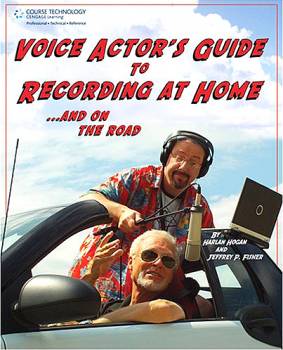 Is this "Ride Gain"? Or maybe home studio Easy Riders Harlan Hogan (driving) and Jeffrey P. Fisher (recording) are speeding us to Part 2 of their handy / hilarious glossary of voice over home studio terms ...
Part 2: Letters M to Y ...
The Glitzy, Ditzy Home Recording
Studio GLOSSARY - Learn & Laugh!
 This glossary is reprinted with permission from the Voice Actor's Guide to Recording At Home ... And On The Road - a soup-to-nuts guide to creating an inexpensive but professional-sounding recording studio in your home or on the road - with lots of laughs! Co-author and voice-over legend Harlan Hogan is also the inventive creator of the Voiceover Essentials online store. This glossary is reprinted with permission from the Voice Actor's Guide to Recording At Home ... And On The Road - a soup-to-nuts guide to creating an inexpensive but professional-sounding recording studio in your home or on the road - with lots of laughs! Co-author and voice-over legend Harlan Hogan is also the inventive creator of the Voiceover Essentials online store.By Harlan Hogan and Jeffrey P. Fisher
A glitzy, glowing, glimmering, glamorous – glossary! Our oh-so-handy guide to arcane audio terminology for posturing, posing, pontification pundits.
Please click here for letters A to L, or visit:
M to Y
Mask
1. To hide, cover up or make a sound inaudible by playing another sound along with it.
2. See also Carry, Jim.
Microphone (Mic)
1. Metal thing one speaks into as greenbacks emerge from other end.
2. Metal thing that is a transducer, i.e. a device that converts an acoustical signal (sound) into an electrical signal. See also Loudspeaker.
3. Abbreviation is mic pronounced like the name "Mike," Harlan and Leslie's Newfoundland-Lab mix.
MIDI
1. Abbreviation for Musical Instrument Digital Interface. This is a common encoding language that allows synthesizers, drum machines and computers to communicate with and/or control each other.
2. Popular leg-revealing dress style remembered fondly by gentlemen of a certain age.
Mixdown
1. The process of playing one or more recorded tracks through a physical or virtual mixing console and combining them into one combined audio track.
2. Julia Child's technique for combining ingredients without splattering the ceiling.
Mixer (Mixing Board)
1. A hardware device that mixes and combines audio signals and controls the relative levels of the signals. Many mixers also have equalization controls, pan pots, monitoring controls, solo functions, channel assigns, and can control how signals get sent to external devices.
2. Mixing console.
3. Control surface.
4. Stupid party whose aim it is to acquaint boring people with other equally boring people they have no desire to be acquainted with.
Monitor
1. Fancy name for expensive loudspeaker.
2. Video display screen used with a computer.
2. Carnivorous lizards including the King Kong of reptiles, the Komodo Dragon.
4. U.S. ironclad warship.
Monitoring
1. Listening to an audio signal with a monitor or headphones.
2. Civil War-era derogatory slang for sailors who drowned, referring to the 16 who died when the USS Monitor sank in a storm off Cape Hatteras in 1862.
Mono (Monophonic)
1. A single channel of audio with the same sound coming from all monitors or speakers.
2. The so-called kissing disease mononucleosis.
MP3
1. A lossy format that enables audio MP3’s to be distributed on the Internet with short upload and download times compared to WAV or AIF files.
Muddy
1. Unclear sounding; having excessive leakage, reverberation, or overhang.
2. The late McKinley Morganfield. .
Multitrack
1. Hardware or software that can separately record and play back one or more tracks.
2. Churchill Downs.
Mute
1. To turn off an input or output signal on a mixing console.
2. Clown White-faced sorry-sad-sack, forever trapped in an invisible box.
Near-Field Monitoring
1. Mixing audio by placing the speaker (monitors) very close to the listener, lessening the influence of the control room's acoustic sound.
2. Attempting a mix near Clark & Addison on game day.
Off-Axis
1. Performer who isn’t directly in front of a directional microphone.
2. Device popular with executioners before Messier Guillotine’s invention.
Omnidirectional Microphone
1. A microphone that is sensitive to sounds arriving from all directions.
2. A microphone that has yet to find it’s true raison d’art; thus it is unfocused, and easily distracted by sounds arriving from all directions.
Outboard Equipment
1. External gear or programs outboard of the mixing console.
2. Evinrude, Nissan and Mercury are good examples.
Output
A connector in an audio device from which the signal comes, and feeds successive devices.
Out-Take
1. A take, or section of a take, that is to be removed or not used.
2. A take, or section of a take, that is then embarrassingly posted throughout the Internet.
3. Slang for carryout or – as the British say – takeaway. See, we told you the British are weird.
Overdub
1. To record a new musical part on an unused audio track in synchronization with previously recorded tracks.
2. Too much of a good dubbing.
Pad
1. A setting to reduce volume (attenuate) by a pre-set amount.
2. Beatnik slang for crib.
Pan Pot
1. Abbreviation for Panoramic Potentiometer. How’s that for cool phraseology? On mixing consoles, a pan pot control divides a signal between two or more channels in an adjustable ratio. For example, the left and right channels of a stereo signal.
2. Partygoer's opinion of bad grass.
3. The chef's perennial decision dilemma: use the frying pan or the stock pot?
Patch
1. To connect one piece of audio equipment to another with a cable. See also Tape, Duct.
Patch Bay (Patch Panel)
1. Multiple jacks wired to various audio inputs and outputs, making it easy to interconnect various pieces of equipment from one place.
2. The easy way to interconnect all your outboard gear.
3. Uber-exclusive, secluded and gated Caribbean retirement community.
Patch Cord
1. A short cable with plugs on both ends, used to route audio in the patch panel.
2. Decorative eyewear accessory, favored by members of the Members-Only Patch Bay Yacht Club.
Peak
1. On a graph of a sound wave or signal, the highest point in in the waveform’s amplitude.
2. Harlan’s career – 20 years ago.
Phantom Power
1. DC voltage (usually 48 volts) used to power condenser microphones.
2. Unexplainable and inexplicable fan base that demands constant revivals of the interminable Andrew Lloyd Weber musical.
Phase
1. The degree of progression in the cycle of a sound wave. (A complete cycle is 360 degrees.)
2. Adolescense.
Phase Cancellation
1. The elimination of certain frequencies in a signal, when that signal is combined with its (slightly delayed) duplicate.
2. Graduation.
3. Leaving the familial homestead.
4. Parental cessation of support.
5. Student loan repayment begins.
Phone Patch (Patch Session)
Remote recording session conducted via Plain ‘Ole Telephone Service (POTS), ISDN (Integrated Services Digital Network) or VOIP (Voice Over Internet Protocol).
Phone Plug (Phono Plug)
1. A cylindrical plug (usually 1/4-inch diameter).
2. An unbalanced phone plug’s tip carries the hot signal and the sleeve (the tube portion) the shield or ground.
3. A balanced phone plug has a tip for the signal hot signal, a ring for the return signal, and a sleeve for the shield or ground (Tip-Ring-Sleeve or TRS).
4. An RCA or S/PDIF phone plug has a central pin for the hot signal and a ring of pressure-fit tabs for the shield or ground.
5. Unsolicited commercial on telephone - cell spam.
Pitch
1. Late night Infomercials that seem to solve all the world’s problems in three easy payments.
2. The relative lowness or highness of a sound; it’s fundamental frequency.
Plug-In
1. Software audio effects that you install in your computer.
2. The very first step in audio production.
Polar Pattern
1. The directional pickup pattern of a microphone such as omnidirectional, bidirectional, unidirectional, cardioid, super cardioid, and hyper-cardioid. (Note: Hypercardiodism can often be controlled through the use of drugs like Ridilin.)
2. Alarming result of Global Warming. An emerging pattern of migration is being noted by scientists - as most North Pole animals are catching busses to the nearest Zoo.
Pop
1. A thump/explosives sound heard in a voice-over’s track. Pop occurs when the user says words with "p," "t," or "b" so that a turbulent puff of air is forced from the mouth and strikes the microphone diaphragm.
2. A noise heard when a mic is plugged into a monitored channel, or when a switch is flipped.
3. Overly-familiar term of endearment for voice talent of a certain age, i.e., "Pop’s dozing in the Green Room. Shall I wake him up?”
Pop Filter
1. A screen placed on a microphone grille that attenuates or filters out pop disturbances before they strike the microphone diaphragm. Usually made of open-cell plastic foam or silk, or metal, a pop filter reduces pop and wind noise.
2. Ok, the down and dirty truth is this thing keeps saliva off the delicate and expensive-to-replace microphone diaphragm. However, pop filter sounds better than spit filter in mixed company.
3. Bouncer at a trendy nightclub who refuses entry to men of Hralan's age.
Preamplifier (Preamp)
1. In an audio system, the first stage of amplification that boosts a mic-level signal to line level. A preamp is a stand-alone device or a circuit in a mixer.
2. Similar to pre-nuptial agreement – slang for taking more than 50% or marital assets. "Man I pre-amplified him!”
Prefader / Postfader Switch
A switch that selects a signal either ahead of the channel fader (prefader) or following the fader (postfader).
Proximity Effect
1. The increase in bass when speaking very closely into a directional microphone.
2. Another loser movie from M. Night Shyamalan.
Punch In / Out
1. In recording, this is the ability to insert a new track into a previously recorded track.
2. What people with real jobs have to do at the beginning and end of their shift.
Rack
1. A 19-inch-wide wooden or metal cabinet used to hold audio equipment.
2. Antlers
3. Not even thinking that. Really we’re not.
Radio Frequency Interference (RFI/RF)
1. Noise (often distant radio stations) picked up by audio cables or equipment.
Ribbon Microphone
A dynamic type of microphone using a long metallic diaphragm (ribbon) suspended in a magnetic field.
Ride Gain
1. To turn down the volume of a microphone when the source gets louder, and turn up the volume when the source gets quieter.
2. Tonto’s second cousin twice-removed’s mount.
Sampling
1. Recording a short sound event into the computer memory. The audio signal is converted into digital data representing the signal waveform, and the data is stored in memory chips, tape or disc for later playback.
2. Indulging in an entire box of Whitman’s finest.
Scratch Track
1. Rough VO: recording usually done by a non-professional for client approval.
2. What the DJ does in a hip-hop group
3. A sure way to get a spanking back in the 78 and 45 rpm record days, according to Mr. Hogan.
See Also
See also See Also.
Sensitivity
1. The output of a microphone in volts at certain sound pressure levels.
2. Mrs. Fisher & Mrs. Hogan – in solidarity – claim we don’t know anything about this, so we defer to their collective wisdom.
Shock Mount
1. A suspension system that isolates a microphone from its stand.
2. Black stallion ridden by Abraham "Brom Bones” Van Brunt in The Legend of Sleepy Hollow.
Sibilance
1. Harsh and shrill "S” sounds in the 5- to 10 kHz range.
2. Brothers and sisters you wouldn’t deign to even speak to if you weren’t somehow – through a cruel trick of nature - related to them.
Signal-To-Noise Ratio (S/N)
The ratio (in decibels) between signal and noise. An audio component with a high S/N has very little background noise, but a component with a low S/N is noisy.
Slap, Slapback
1. An echo following the original sound by about 50 to 200 milliseconds, sometimes with multiple repetitions.
2. A Three Stooge’s staple.
Slate
1. At the beginning of a recording, the engineer announces name and/or number of the take.
2. The most expensive roof one could possibly imagine over one’s head and one that the lovely Lesley Hogan wants Mr. Hogan to install instead of that tar-paper thing they have at the moment, as soon as the royalties from this book come a’ rollin in.
Sound Card
See Analogue to Digital Converter.
Speaker
See Loudspeaker/monitors.
Standing Wave
1. The build-up of certain frequencies in a space due to the acoustic reflection between opposite room surfaces.
2. Appreciative gesture given by audience to a performer who doesn't quite deserve a standing ovation.
Take
1. A recorded performance. Usually, many takes are done, and a whole take or the best parts of several takes are assembled into a "hero” take.
2. Amount received by actor.
Talkback
1. Essentially an intercom in the mixing console for the engineer and producer to talk to the voice actors in the studio.
2. See also Phase and Phase Cancellation.
Transient
1. A short signal with a rapid attack and decay, such as a drum stroke, cymbal hit, or acoustic-guitar pluck.
2. Hotel frequented by actors, musicians and former ad executives.
Tweeter
1. A high-frequency loudspeaker.
2. Sylvester’s’ nemesis.
Unity Gain
1. A steady state signal with no increase or decrease in strength at the output of an amplifier or device, compared to the signal strength at the input.
2. Increase in weight observed throughout the populace of Northwestern Minnesota during February.
Valve
British term for vacuum tube. They just get weirder and weirder, don’t they?
Virtual Track
1. The computer's equivalent of a tape track on a multitrack tape recorder. A key component of mixing.
2. Second Life’s ever-popular, always jammed, Jameson Straights Racecourse - admission 17.00 Linden dollars.
VU Meter
Abbrebiation for Volume Units. The VU meter shows relative volume of signals.
Waveform
1. The graphic representation of audio.
2. Movement of one's hands to acknowledge others. Popular examples include the enthusiastic "Yo wave" and the restrainted Queen of England's "I'm moving my hand back and forth but ignoring your existence, you commoner you, wave." We don't need to mention how weird that is.
Woofer
1. A low-frequency loudspeaker.
2. Ally, the Hogans' Border Collie / Chow mix.
Workstation
1. A system of MIDI- or computer-related equipment that helps you compose and record music. Usually, this system is small enough to fit on a desktop or equipment stand. See also Digital Audio Workstation.
2. Popular daytimer AM in the outskirts of Lansing, Illinois reputed to be owned by Woodrow Orren Robert Kensington the third, Lansing’s leading land baron and sponsor of the Lan-Oak Park Fourth of July fireworks.
XLR
1. Oldies station in Graham, Georgia, where Harlan did his first DJ gig. When his Chicago accented double-u in WXLR sounded to management like doubyaw XLR, they obligingly removed the offending consonant.
2. A tube-shaped 3-pin balanced professional audio connector.
Y-Adapter
1. A cable that combines two audio signals into one or separates one into two.
2. That nagging question - whilst deciding whether to take home the Tabby or the Maine Coon kitten, from Orphans of the Storm Animal Shelter.
For more about all home studio topics, check out the The Voice Actor’s Guide to Recording at Home & On the Road, 2nd Edition.
ABOUT HARLAN & JEFFREY ...
Harlan Hogan has been voice acting for more than 30 years, giving voice to many recognizable ad campaigns, including, "It’s the cereal even Mikey likes,” and "Hey Culligan Man!” He’s also heard on countless documentaries and is the familiar voice on PBS saying, "This program is made possible by … Thank you.” Based near Chicago, he is also author of VO: Tales and Techniques of a Voice-Over Actor.
Email: harlan@harlanhogan.com
Web: www.harlanhogan.com
Store: Voiceover Essentials
Jeffrey P. Fisher is an award-winning and in-demand sound engineer, instructor of sudio and video production and post production, the author of 11 books, and specializes in digital content creation, including words, music, sound and visuals. He works form his Illinois project studio on a variety of music, writing and multimedia products.
Email: jpf@jeffreypfisher.com

Your Daily Resource For Voice-Over Success
|
Tell Us What YOU Think!
Please Note: Since we check for spam, there will be a slight delay in the actual posting of your comment.
Comments
No comments have been posted yet. Hurry, and you could be the first!


.png)






click for new article alerts